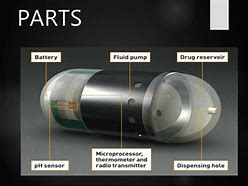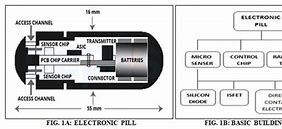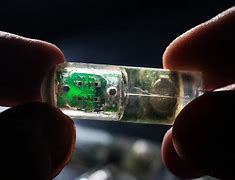DIGITAL SMART PILLS
duckduckgo query: digfital pills
images
videos
duckduckgo query: digital smart pills
digital smart pills at DuckDuckGo
images
digital smart pills at DuckDuckGo
videos
digital smart pills at DuckDuckGo
TYPES OF DIGITAL PILLS
Imaging Capsules
Gas Sensing Capsules
Medication Monitoring Capsules
Electrochemical Sensing Capsules
Sensing Targets
Oral Cavity
Esophagus
Stomach
Colon
Digital pill
A digital pill (also known as smart pill, ingestible sensor) is a pharmaceutical dosage form that contains an ingestible sensor inside of a pill. The sensor begins transmitting medical data after it is consumed. The technology that makes up the pill, as well as the data transmitted by the pill's sensor, are considered to be part of digital medicine. The purpose of the sensor is to determine whether the person is taking their medication or not (called "compliance"). There are privacy concerns with respect to who receives the data and what is done with it.
The first emergence of a swallowable electronic device was in 1957, this device used radio frequency to transmit temperature and pressure readings. The field lay stagnant until technology caught up with invention in the 1990s. The first digital pill to be approved by the United States Food and Drug Administration (FDA), a version of aripiprazole (Abilify) manufactured by Otsuka Pharmaceutical, was approved in November 2017. This digital pill's sensor, developed by Proteus Digital Health, is activated by acid in the stomach, and generates an electrical signal that is picked up by a patch worn on the ribcage; the patch in turn forwards information to a smartphone app. The drug is taken by people with schizophrenia. People with the condition tend to have problems with adherence, and the digital pill could help with that; however some people with schizophrenia have paranoia which the digital pill could make worse.
Types of Digital Pills
The most common types of ingestible sensors are used for imaging, sensing different types of gasses, to monitor medication compliance or absorption of medication, and electrochemical signal sensing.
Imaging Capsules
Images and video require the highest bandwidth for data delivery. Ingestible capsules containing video cameras are used for generating images of the macroscopic structures of hollow organs, such as the stomach and small bowel. These devices are powered by batteries, can transmit video at up to 2.7 Mbit/s, and are less invasive than other traditional endoscopic imaging devices.
Gas Sensing Capsules
Gas Sensing Capsules utilize a gas-permeable membrane surrounding an electrochemical gas sensor and are primarily used to detect the partial-pressures of different gasses produced as the byproduct of metabolic reactions by bacteria in the intestines. The presence of gasses like carbon dioxide and methane in the gut provides useful data for analysis of metabolic and digestional health. This internal measurement of a body's organs provides a superior analysis in terms of accuracy and reliability as compared to the traditional technique of breath-test analysis.
Medication Monitoring Capsules
Ingestible sensors that are specific for the monitoring of the absorption of medication or compliance will also signal the user that medication needs to be taken. These are activated in the stomach by pH differences and will transmit via Bluetooth.
Electrochemical Sensing Capsules
Voltammetry can be used in vitro on stool liquid as a Gi tract diagnostic tool. The device would be able to perform cyclic, square wave, and differential pulse voltammetries.
Sensing Targets
Due to the nature of ingestible sensors, they are optimized for passage through hollow organs. This makes them ideal for data collection throughout the digestive tract, which includes multiple organs between the mouth and anus.
Oral Cavity
The most common clinical targets for the ingestible sensor in the oral cavity would aid in the determination of: electrolyte imbalances, body metabolism based on chemical makeup of saliva, hormonal imbalances, infectious conditions, i.e. HIV and viral hepatitis, allergy disorders and cancer.
Esophagus
Digital pills that have imaging capabilities are used in endoscopy to look for inflammation and lacerations in the esophagus. The mucosa contained in the esophagus can also be tested to look for issues such as eosinophilic esophagitis.
Stomach
The pH value of the stomach is important for proper digestion and is something that can be detected by certain types of digital pills. Stomach enzymes and electrolyte production are also able to be detected by a digital pill. These pills can also search for specific bacteria in various areas of the body. For example, digital pills can be programmed to search for helicobacter pylori in the stomach, which is known to be a cause of ulcers.
Colon
The potential targets would be to monitor stool (colonic content) for medical diagnosis of infection (parasite, viral, or bacterial sources), poor nutrient absorption, or colon cancerr. Also, the ingestible sensor could do an internal colonoscopy that would be less invasive than traditional.
Powering the Digital Pill
Most digital pills use silver-oxide batteries. Lithium ion batteries are dangerous to the human bodies digestive system and therefore cannot be used.
Passive and Active Digital Pill Locomotion
Most digital pills rely on passive locomotion, or allowing the body's digestive system to do all the work moving the pill, however some pills do utilise active locomotion. One active locomotion method is to include a small magnet in the digital pill that can then be activated by an external magnetic field, which can then move the pill from outside the body.
Device Safety
It is possible that the digital pill and pacemakers may interfere with each other, however, this has not been verified.
What Is a Digital Pill? - videos
A sand-grain sized ingestible sensor was designed to address some of medicine’s biggest challenges. Here's a look at what it's made of it and how it works. This video has been updated to clarify the roles of Proteus and Otsuka in the technology.
https://www.wsj.com/video/what-is-a-digital-pill/6A4444D6-DBAD-421A-8B53-C51E23A20268.html
Digital health technology for use in patients with serious mental illness: a systematic review of the literature
FDA Approves First Digital Pill That Can Track Whether You've Taken It (2017)
FDA Approves First Digital Pill That Can Track Whether You've Taken It : The Two-Way : NPR
FDA approves pill with sensor that digitally tracks if patients have ingested their medication
FDA approves pill with sensor that digitally tracks if patients have ingested their medication | FDA
INGESTIBLE PILLS
Ingestible Sensors
Ingestible Sensors | ACS Sensors
Ingestible sensing capsules are fast emerging as a critical technology that has the ability to greatly impact health, nutrition, and clinical areas. These ingestible devices are noninvasive and hence are very attractive for customers. With widespread access to smart phones connected to the Internet, the data produced by this technology can be readily seen and reviewed online, and accessed by both users and physicians. The outputs provide invaluable information to reveal the state of gut health and disorders as well as the impact of food, medical supplements, and environmental changes on the gastrointestinal tract. One unique feature of such ingestible sensors is that their passage through the gut lumen gives them access to each individual organ of the gastrointestinal tract. Therefore, ingestible sensors offer the ability to gather images and monitorluminal fluid and the contents of each gut segment including electrolytes, enzymes, metabolites, hormones, and the microbial communities. As such, an incredible wealth of knowledge regarding the functionality and state of health of individuals through key gut biomarkers can be obtained. This Review presents an overview of the gut structure and discusses current and emerging digestible technologies. The text is an effort to provide a comprehensive overview of ingestible sensing capsules, from both a body physiology point of view as well as a technological view, and to detail the potential information that they can generate.
Ingestible Sensors
Ingestible Sensors - PubMed (nih.gov)
Superscript
Block title
This is a block description. To edit, click and type the text or replace it with your own custom content





